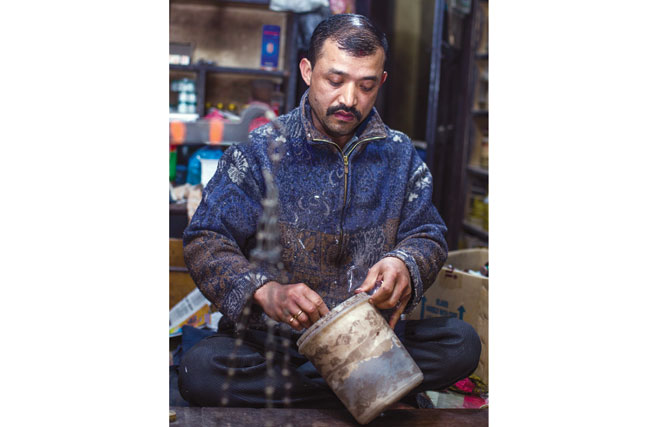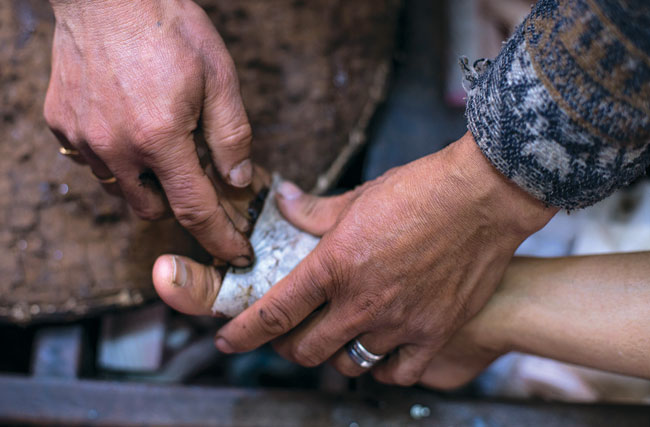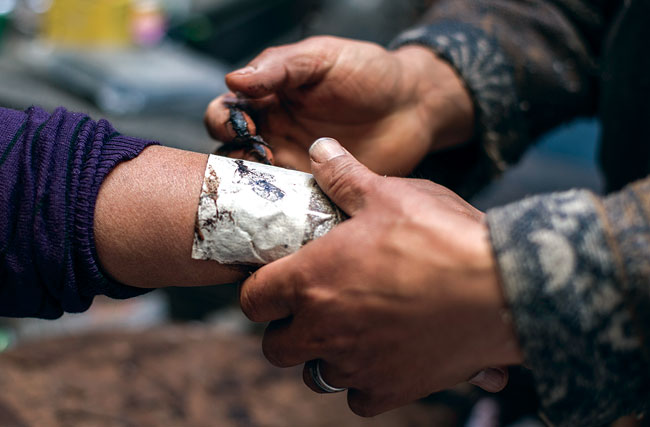Ramesh Shakya dispenses knowledge and care to his patients as he continues a family legacy that is both fascinating and a little mysterious.

When I approached Ramesh Shakya’s little shop, I was struck at once by the crowd surrounding it. To get here I’d passed several other Ayurvedic shops, stacked high with herbs and remedies, andthere had been no crowds there. But here, just minutes after opening for the afternoon, was a varied collection of people waiting for this man’s time. It took me a while to get a chance to talk to him, but I didn’t mind: just watching was fascinating, and somewhat of an education.
The small shop is down ChokachhenGalli, near IndraChowk, and I would never have found it without help from a savvy local friend. As I leaned inside, the air was full of a smell I couldn’t identify—pungent but pleasant—that I can only guess is an amalgamation of decades of herbs, spices, tinctures, and poultices.
Ramesh Shakya makes his own medicines from ancient handwritten texts that he has in his possession. While he does stock packaged remedies, that is clearly not the main thing people come to him for. Instead, they come for his personalized attention, consultation, and treatment. One after another, people came and sat on the two low seats, surfaces shiny from much use, set to the left and right of the tiny shop’s entrance. There, people would remove a shoe so their foot could be examined, or pull up a sleeve to show a painful spot on their arm. Ramesh asks questions, pokes and prods, before offering his diagnosis, generally in the form of a leporpangra, known in English as a poultice, administered from one of a line of receptacles, or directly from the dark goopy mass that filled the large mortar and pestle sitting alongside.
After smearing the lep on the affected spot and rubbing it in carefully, he then covers the area with either a patch of cotton wool or a piece of Nepali lokta paper, before wrapping it further with gauze. When I asked him why he used cotton for some and paper for others, he explained that if there was swelling, the paper could tighten and become painful, so for those cases the cotton is used.

At first glance, it might seem as if he offered the same remedy to everyone, but that was not the case. As I watched patient after patient, I saw that even though the lep was the primary remedy, the kind of lepand its ingredients varied, depending on the ailment.
One limping young man had brought an x-ray of his foot along, and after examining both his foot and the film, Ramesh told him he needed to go to a hospital and get a plaster cast put on it. “Can’t you put a lep on it?” the young man nearly begged. “No, that’s not what you need,” Ramesh replied firmly, offering the best evidence, if such was needed, that he was not just in it to treat as many people ‘his way’ as possible, but that he truly wanted what he believed to be best for them. If people did not receive treatment, he did not charge, no matter how long he’d spent examining and talking with them. For those he did treat, the charge for the basic lepwas a minimal 80 rupees, a bargain by any standards, but particularly when combined with the clearly expert, individualized advice his patients were receiving.
People kept coming, and only rarely during the time I spent there—over an hour and a half—were there moments when the shop had only a patient or two waiting. Most of the time there were many, many, more. In between the application of leps and dispensing of advice, Ramesh also paid bill collectors as they dropped in, received shipments of medicines, and answered my questions, all with calm and a friendly, relaxed manner. He is certainly an expert multi-tasker, but more than that, he seems to have an innate ability to make people feel at ease; laughter often rippled through the crowd during the conversations. And even though the shop never seemed to empty while I was there, people were friendly to each other, without the pushing and grumpiness you often see at a truly busy place that everyone is trying to get into.
Ramesh Shakya’s family has been in this business for three or four generations, and his son is now studying at the university in Pune to become an Ayurvedic doctor, as well. The title of vaidya or kaviraj, he explained, is the Ayurvedic equivalent of a doctor, and it’s a profession he himself has been practicing for 40 years now. Many people in this part of town have been coming here for generations, both because of him and his ancestral reputation.
To me, meeting Ramesh Shakya felt more like a privilege than a writing assignment. I stayed there much longer than I intended to that day, listening to people as they explained their woes—when I could understand them, that is—and examining the tiny shop’s interior with its shelves full of clear containers and mysterious opaque receptacles, the ceiling completely covered with labeled herb-filled plastic bags. Before I left, I surprised myself by asking for my own consultation—a painful leg that’s been bothering me for weeks now—and was sent home with a small container of custom mixed lep with instruction to massage it into the painful spot twice daily. The dark color nearly put me off, but I was pleasantly surprised to discover when I opened it that it smelled of licorice and eucalyptus. And all those regular customers can’t be wrong, can they?

Update: It’s been a week now, and morning and evening I’ve smeared the lep on my leg, rubbing it in thoroughly. Surprisingly (to me) it does feel better; though whether that’s the mysterious herbs contained therein or the self-massage I’m giving my leg, I can’t presume to say. And while I may not yet be a true believer, this experience has certainly made me another of Ramesh Shakya’s satisfied customers.
If you feel inclined to take your ailment to Nepal’s own medicine man, go to Indra Chowk, and from there ask the way to Chokachhen Galli. You can probably find his nameless shop from the crowd that surrounds it or the mini-traffic jam they cause, but if you can’t, just ask for Ramesh Dai’s shop. It’s open punctually from 8 a.m. to 12 noon, and again from 4-8 p.m.









